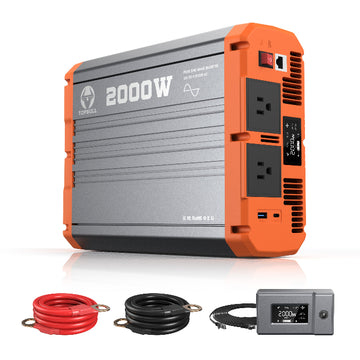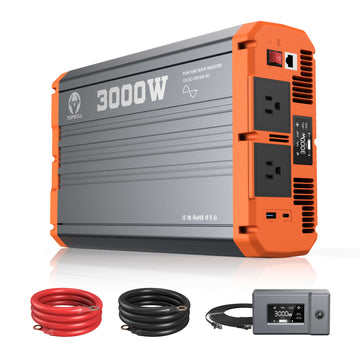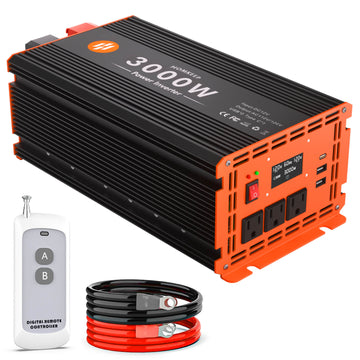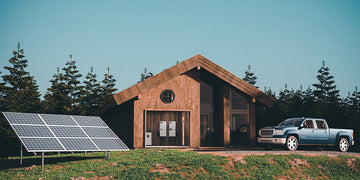Pellet stoves provide environmentally friendly heating, but power outages can affect their operation. Without a reliable inverter, it can easily expose you to the bitter cold. This guide explores how to choose the best inverter for your pellet stove.
How do I power my pellet stove without electricity?
In the event of a power outage, pellet stoves can rely on batteries and an inverter to power the motor. The battery provides the DC power, and the inverter acts as a "bridge" to convert the DC power to AC power.
Main features of a pellet inverter
The stable operation of a pellet stove is highly dependent on the reliability of the electrical system, so the inverter must fulfill the following key functions:
Pure sine wave output
The sensitive electronics inside the pellet stove must accept only a smooth sine wave current that matches the quality of the utility power. Corrective sine wave or square wave inverters can produce harmonic distortion, leading to problems such as overheating of the motor coils (which can heat up by as much as 15-20%) and false shutdown codes triggered by the control board.
High-quality pure sine wave inverters ensure that the current waveform distortion rate is <3%, which not only reduces equipment losses but also reduces operating noise, which is especially suitable for nighttime heating scenarios.
Battery compatibility
Modern pellet stove users often use 12V/24V/48V battery systems with different voltages and intelligently recognize the differences in the chemical characteristics of lithium batteries, lead-acid batteries, and so on.
Take Topbull inverter as an example; its built-in BMS communication interface can automatically match the charging and discharging curves of lithium iron phosphate batteries, increasing the battery utilization rate to 95% and avoiding the risk of over-discharging caused by voltage miscalculation in traditional inverters.

Protection functions
Usually, the protection functions of the inverter include overload protection, over-voltage protection, under-voltage protection, short-circuit protection, over-heating protection, etc. Pellet stove running for a long time may encounter voltage fluctuations, temperature changes, and so on. It may be necessary to add some pellet stove-specific protection functions, such as motor blocking protection or dust environment protection.
Environmental adaptation
Low temperatures will reduce the battery's efficiency, so inverters installed in garages or outdoors need to be protected from moisture and cold. For cold regions, some inverters are equipped with self-heating battery compartments to warm the batteries to above 0°C before starting in cold conditions.
How much electricity does a pellet stove use?
Typical pellet stove output ranges from 300-800W depending on the model:
- Small Furnace (≤1,500 square feet): 300W~500W
- Medium-sized furnace (1,500~2,500 square feet): 500W~650W
- Large furnace (≥2,500 square feet): 650W~800W
Pellet stoves do not run at full capacity 24 hours a day, and the actual power consumption needs to be calculated in conjunction with the operating cycle and climatic conditions.
Daily power consumption (Wh) = power (W) x daily running time (hours)
Assuming a 500W furnace and 4 hours of operation per day, a battery reserve 2,000Wh (i.e. 2kWh) is required.

What size inverter do I need for a pellet stove?
Choosing the right size inverter for your pellet stove is critical. An underpowered inverter can lead to equipment damage or downtime, while an overpowered one can be inefficient and waste energy.
- Determine the rated power of the pellet stove: The operating power of the pellet stove is indicated on the nameplate or in the instruction manual.
- Calculate the inrush power requirement: Pellet stove motors generate an inrush current at the moment of startup, usually 1.5 to 3 times the rated power. The total inrush power needs to be superimposed on the peaks of all motors (not simply added to the rated power). A 500W pellet stove with a surge factor of 2 requires an inverter to support at least 1000W of surge power.
- Account for system efficiency loss: The inverter will generate efficiency loss in the process of DC to AC flow. To ensure long-term stable operation, it is recommended that the inverter continuous power to leave a margin of 20%.
- Match the battery system voltage: The DC input voltage of the inverter must match the battery pack. A 12V system is usually suitable for small-sized furnaces with power ≤1000W. 24V/48V system is suitable for medium-sized and large-sized furnaces with power ≥800W, which has higher efficiency and lower wire cost.
Pellet stove inverter installation and maintenance
Installation location selection
The inverter can be mounted more than 1 meter from the pellet stove on a dry, ventilated wall or stand. Avoid installing directly under the stove, high temperatures can damage the inverter. Next it should be kept away from damp locations such as water pipes.
Wiring operation
1. Turn off the battery main switch, wear insulated gloves
2. Connect the battery:
- Red wire (positive) to the battery "+" pole → series fuse
- Connect the black wire (negative) to the battery "-"pole.
Note: A Reverse connection will burn the inverter! Be sure to check the polarity with a multimeter!
3. Plug in the pellet stove:
Plug the AC output of the inverter into the power outlet of the pellet stove.
or directly into the circuit breaker
Power on test
1. No-load startup: open the inverter switch and observe the indicator light to show that it is normal.
2. Voltage test: Use a multimeter to measure the output terminal; it should be 110-120V (±5%)
3. Load test: Start the pellet stove and observe whether the inverter is running stably (no alarm tone/flashing red light)
Maintenance inspections
1. Appearance check:
- Confirm that the status lights are operating normally.
Feel the temperature of the shell by hand; a slightly warm temperature is within the safe range. - Check the cable to make sure there is no looseness, and observe whether the copper terminals are blackened.
- Check whether the fan blade accumulates dust (the accumulation of dust more than 1mm thickness needs to be removed and cleaned).
2. Check the electrical parameters:
- Measure the AC output with a multimeter: 110- 120V is qualified.
- Access to 500W load (such as electric heaters), the voltage drop ≤ 5V is normal
Learn More: Power Inverter Repair & Maintenance: Essential Tips for Efficiency
Why your pellet stove needs a quality inverter?
Pellet stoves deliver fuel using motor-driven augers and regulate combustion and heat distribution using fans. These components require a steady, continuous supply of electricity. Ordinary inverters (such as Modified Sine Wave models) may not be able to provide a smooth voltage, resulting in motor stalling, increased noise, and even shortened equipment life.
After a user used a cheap inverter, the auger was frequently shut down due to unstable voltage, which eventually led to the clogging of the combustion chamber. Quality inverters avoid such problems by precisely matching the sensitive circuits of pellet stoves with pure sine wave output.
Risks of using incompatible power solutions
- Voltage fluctuations: Inferior inverters may deliver unstable current, causing control board failures (repairs can cost up to $200+).
- Risk of overheating: Overloading or inefficient thermal design can lead to spontaneous combustion of the equipment, especially during prolonged operation.
- Battery depletion: Mismatched inverters can accelerate battery deterioration and shorten the duration of backup power.
FAQ
Q: Can I use a car inverter for my pellet stove?
A: It is not recommended, as most inverters lack continuous power output and safety features.
Q: How long will the batteries last in a power outage?
A: It depends on the battery capacity; pairing it with a high-efficiency inverter will extend the run time.
Q: Which inverter can run a stove?
A: The pellet stove needs to be driven by a pure sine wave inverter, the exact size of which depends on the power required by the pellet stove.












